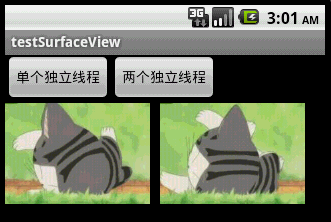前文简单介绍了android中surfaceview的基本使用,本文就来介绍一下surfaceview与多线程的混搭。surfaceview与多线程混搭,是为了防止动画闪烁而实现的一种多线程应用。android的多线程用法与java的多线程用法完全一样,本文不做多线程方面的介绍了。直接讲解surfaceview与多线程的混合使用,即开一条线程专门读取图片,另外一条线程专门绘图。
本文程序运行截图如下,左边是开单个线程读取并绘图,右边是开两个线程,一个专门读取图片,一个专门绘图:

对比一下可以看出,右边动画的帧速明显比左边的快,左右两者都没使用thread.sleep()。为什么要开两个线程一个读一个画,而不去开两个线程像左边那样都“边读边画”呢?因为surfaceview每次绘图都会锁定canvas,也就是说同一片区域这次没画完下次就不能画,因此要提高动画播放的效率,就得开一条线程专门画图,开另外一条线程做预处理的工作。
main.xml的源码如下:
|
1
2
3
4
5
6
7
8
9
10
11
12
13
14
15
|
<?xml version="1.0" encoding="utf-8"?><linearlayout xmlns:android="http://schemas.android.com/apk/res/android" android:layout_width="fill_parent" android:layout_height="fill_parent" android:orientation="vertical"> <linearlayout android:id="@+id/linearlayout01" android:layout_width="wrap_content" android:layout_height="wrap_content"> <button android:id="@+id/button01" android:layout_width="wrap_content" android:layout_height="wrap_content" android:text="单个独立线程"></button> <button android:id="@+id/button02" android:layout_width="wrap_content" android:layout_height="wrap_content" android:text="两个独立线程"></button> </linearlayout> <surfaceview android:id="@+id/surfaceview01" android:layout_width="fill_parent" android:layout_height="fill_parent"></surfaceview></linearlayout> |
java程序的源码如下:
|
1
2
3
4
5
6
7
8
9
10
11
12
13
14
15
16
17
18
19
20
21
22
23
24
25
26
27
28
29
30
31
32
33
34
35
36
37
38
39
40
41
42
43
44
45
46
47
48
49
50
51
52
53
54
55
56
57
58
59
60
61
62
63
64
65
66
67
68
69
70
71
72
73
74
75
76
77
78
79
80
81
82
83
84
85
86
87
88
89
90
91
92
93
94
95
96
97
98
99
100
101
102
103
104
105
106
107
108
109
110
111
112
113
114
115
116
117
118
119
120
121
122
123
124
125
126
127
128
129
130
131
132
133
134
135
136
137
138
139
140
141
142
143
144
145
146
147
148
149
150
151
152
153
154
|
package com.testsurfaceview;import java.lang.reflect.field;import java.util.arraylist;import android.app.activity;import android.graphics.bitmap;import android.graphics.bitmapfactory;import android.graphics.canvas;import android.graphics.paint;import android.graphics.rect;import android.os.bundle;import android.util.log;import android.view.surfaceholder;import android.view.surfaceview;import android.view.view;import android.widget.button;public class testsurfaceview extends activity { /** called when the activity is first created. */ button btnsinglethread, btndoublethread; surfaceview sfv; surfaceholder sfh; arraylist<integer> imglist = new arraylist<integer>(); int imgwidth, imgheight; bitmap bitmap;//独立线程读取,独立线程绘图 @override public void oncreate(bundle savedinstancestate) { super.oncreate(savedinstancestate); setcontentview(r.layout.main); btnsinglethread = (button) this.findviewbyid(r.id.button01); btndoublethread = (button) this.findviewbyid(r.id.button02); btnsinglethread.setonclicklistener(new clickevent()); btndoublethread.setonclicklistener(new clickevent()); sfv = (surfaceview) this.findviewbyid(r.id.surfaceview01); sfh = sfv.getholder(); sfh.addcallback(new mycallback());// 自动运行surfacecreated以及surfacechanged } class clickevent implements view.onclicklistener { @override public void onclick(view v) { if (v == btnsinglethread) { new load_drawimage(0, 0).start();//开一条线程读取并绘图 } else if (v == btndoublethread) { new loadimage().start();//开一条线程读取 new drawimage(imgwidth + 10, 0).start();//开一条线程绘图 } } } class mycallback implements surfaceholder.callback { @override public void surfacechanged(surfaceholder holder, int format, int width, int height) { log.i("surface:", "change"); } @override public void surfacecreated(surfaceholder holder) { log.i("surface:", "create"); // 用反射机制来获取资源中的图片id和尺寸 field[] fields = r.drawable.class.getdeclaredfields(); for (field field : fields) { if (!"icon".equals(field.getname()))// 除了icon之外的图片 { int index = 0; try { index = field.getint(r.drawable.class); } catch (illegalargumentexception e) { // todo auto-generated catch block e.printstacktrace(); } catch (illegalaccessexception e) { // todo auto-generated catch block e.printstacktrace(); } // 保存图片id imglist.add(index); } } // 取得图像大小 bitmap bmimg = bitmapfactory.decoderesource(getresources(), imglist.get(0)); imgwidth = bmimg.getwidth(); imgheight = bmimg.getheight(); } @override public void surfacedestroyed(surfaceholder holder) { log.i("surface:", "destroy"); } } /* * 读取并显示图片的线程 */ class load_drawimage extends thread { int x, y; int imgindex = 0; public load_drawimage(int x, int y) { this.x = x; this.y = y; } public void run() { while (true) { canvas c = sfh.lockcanvas(new rect(this.x, this.y, this.x + imgwidth, this.y + imgheight)); bitmap bmimg = bitmapfactory.decoderesource(getresources(), imglist.get(imgindex)); c.drawbitmap(bmimg, this.x, this.y, new paint()); imgindex++; if (imgindex == imglist.size()) imgindex = 0; sfh.unlockcanvasandpost(c);// 更新屏幕显示内容 } } }; /* * 只负责绘图的线程 */ class drawimage extends thread { int x, y; public drawimage(int x, int y) { this.x = x; this.y = y; } public void run() { while (true) { if (bitmap != null) {//如果图像有效 canvas c = sfh.lockcanvas(new rect(this.x, this.y, this.x + imgwidth, this.y + imgheight)); c.drawbitmap(bitmap, this.x, this.y, new paint()); sfh.unlockcanvasandpost(c);// 更新屏幕显示内容 } } } }; /* * 只负责读取图片的线程 */ class loadimage extends thread { int imgindex = 0; public void run() { while (true) { bitmap = bitmapfactory.decoderesource(getresources(), imglist.get(imgindex)); imgindex++; if (imgindex == imglist.size())//如果到尽头则重新读取 imgindex = 0; } } };} |
希望本文所述示例能对大家进行android的surfaceview与多线程的混搭编程有所帮助。














